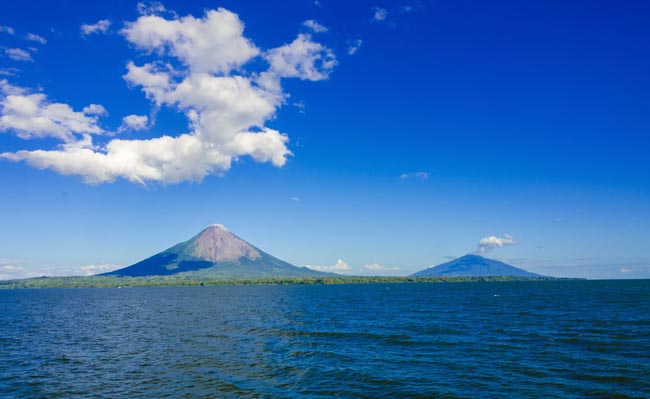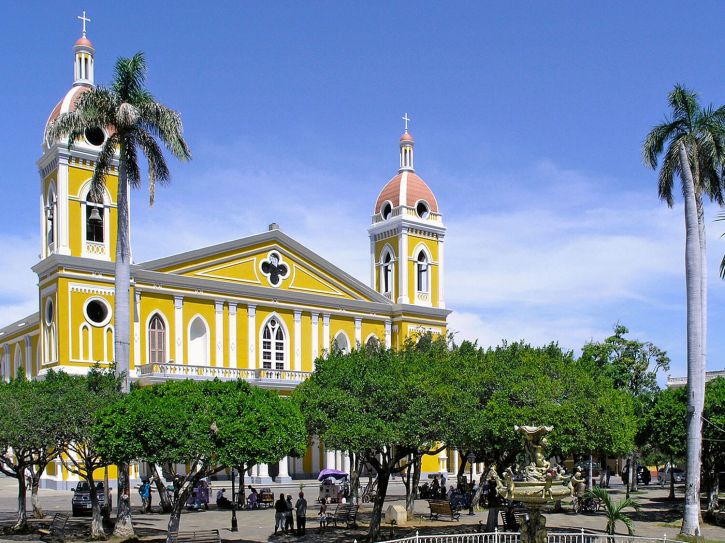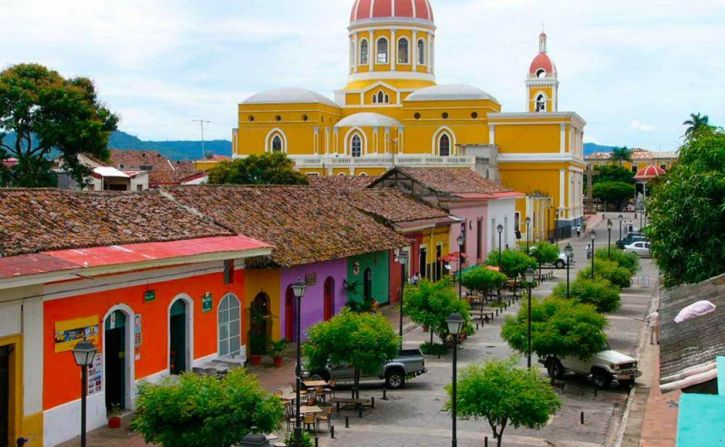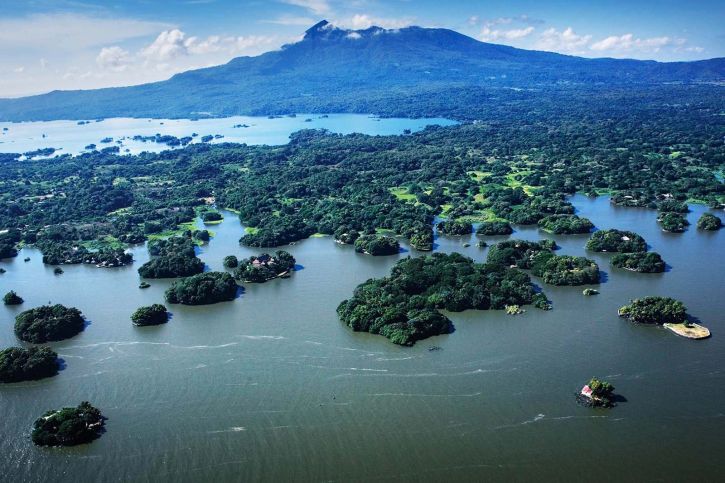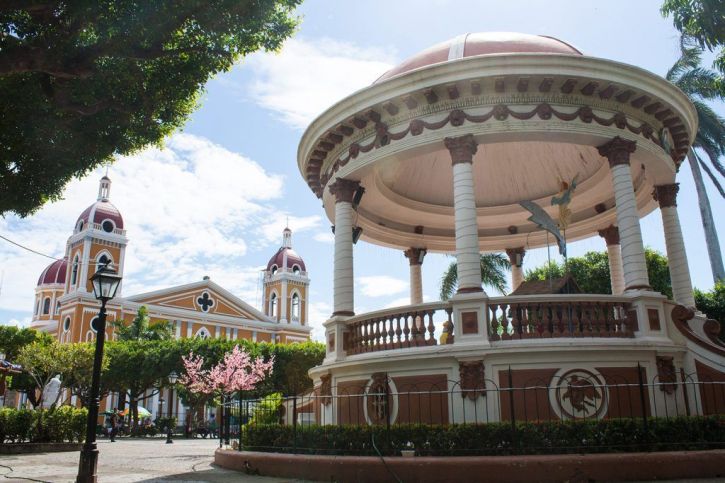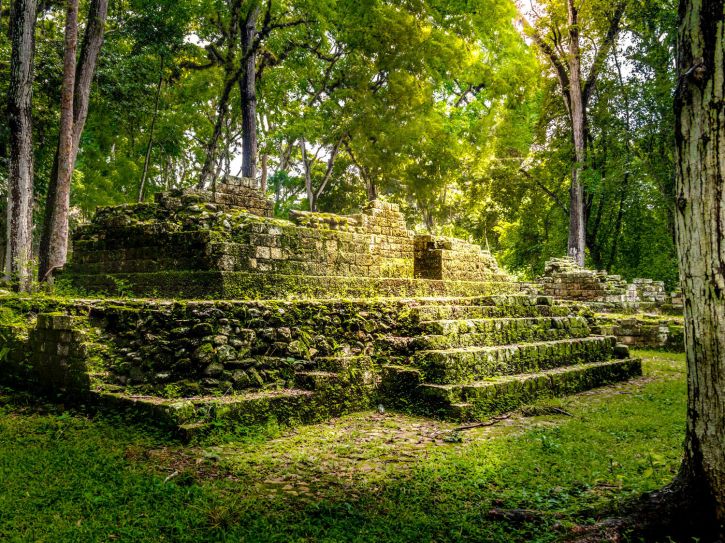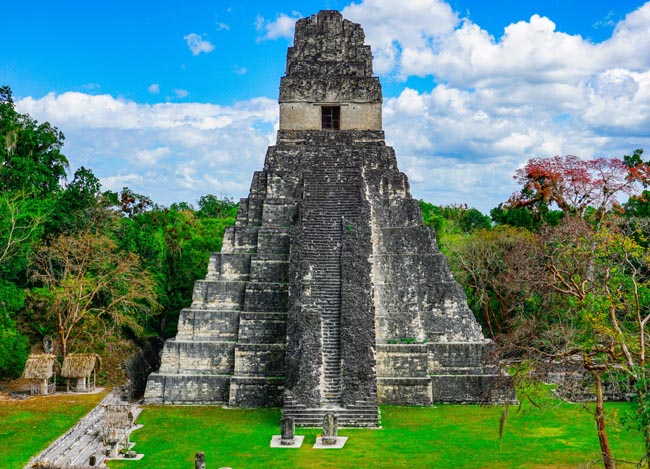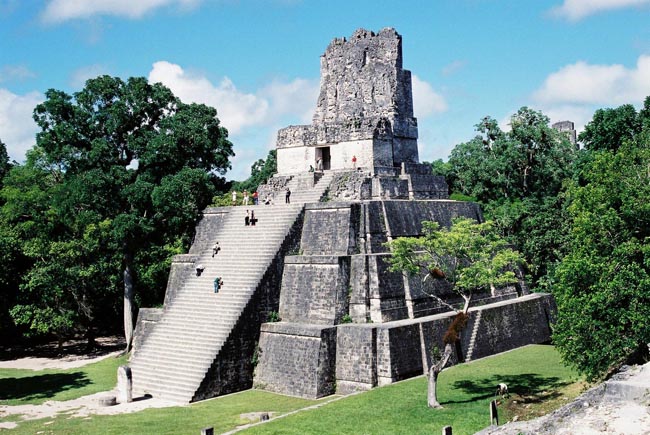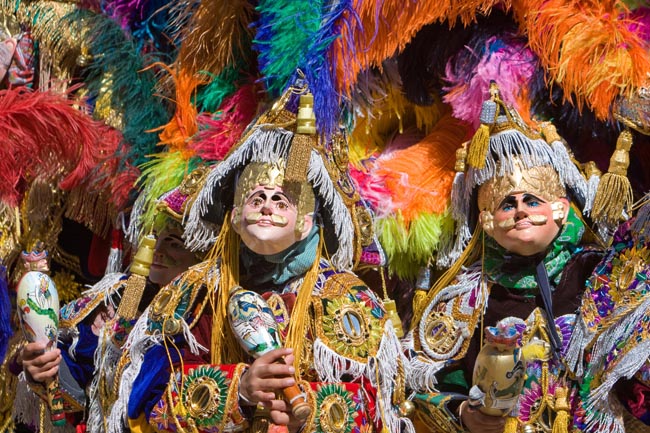Prices below are per person, twin-sharing costs in US Dollars (USD). Pricing does not include airfare to/from the tour and any applicable taxes. For single supplement rates and taxes (if any), please refer to below Prices & Dates table. For general information on flights to/from the tour, click here.
Your Travel and Accommodation Arranged For You
Tips Included for Driver, Restaurant Staff, Local Guides
Authentic Local Experiences With Lots Of Inclusions.
Select a date below to reserve your spot:
Optional Single Supplement: $1150 USD (number of singles limited).
Download Itinerary
Day 1 Arrival in Managua, Nicaragua - Transfer to Granada
Arrival in Managua, Nicaragua; transfer to Granada.*
* As per our usual policies, Land & Air customers will have their transfers to Granada included in their air package; early arrivals will have their transfers included if they book BOTH their air and any extra nights through us. Those booking their own air can purchase a private transfer from us (recommended) or make their own way to our Granada hotel.
Overnight in Granada.
Included Meal(s): Dinner
Day 2 Las Isletas, Masaya Volcano National Park, Laguna del Apoyo, Caterina Viewpoint
The country of Nicaragua derives its name from Nicarao, the name of the Nahuatl-speaking tribe which inhabited the shores of Lago de Nicaragua before the Spanish conquest of the Americas, and the Spanish word Agua, meaning water, due to the presence of the large lakes Lago de Nicaragua (Cocibolca) and Lago de Managua (Xolotlan), as well as lagoons and rivers in the region. At the time of the Spanish conquest, Nicaragua was the name given to the narrow strip of land between Lake Nicaragua and the Pacific Ocean. This is the largest yet most sparsely populated country in Central America.
We start our day with a private boat cruise on Lake Nicaragua. This journey will take us through the Granada Isletas, an exotic tropical archipelago of 365 tiny volcanic islands. Granada is a port on giant Lake Nicaragua, and a boat journey to visit Las Isletas just offshore is a must for any traveller. Some of the 365 islands are inhabited and most are covered with a vast variety of unusual vegetation. This is also an area rich with bird life.
Canals separate many of the isletas where fishermen, seated patiently on Indian rafts, wait fish with nets. Of archaeological interest is the Fortress of San Pablo, placed strategically on an island opposite the city. The fortress was built in the mid- 18th century to protect Granada from the marauding pirates. It was restored in 1974. Pre-Columbian archaeological stone pieces were found on Pensacola Islet and are on exhibit in the Museum of the San Francisco Convent.
In the afternoon we will enjoy an excursion to the famous Masaya Volcano National Park, Nicaragua's first national park, established in 1979 and considered one of Nicaragua's most interesting and beautiful natural phenomena. We will explore the crater rim of this active volcano, which resembles a lunar landscape, and will visit the park museum (our program here may be impacted by volcanic activity levels at the time of our visit).
We will also visit the Caterina viewpoint over Laguna del Apoyo, for a breathtaking view over Granada and Lake Nicaragua. Caterina, a small caldera village part of the Los Pueblos Blancos, is also the viewpoint where a young Augusto Sandino contemplated decisions and planned for the future liberation of Nicaragua.
Overnight in Granada.
Included Meal(s): Breakfast and Dinner
Not finding what you're looking for?
Our specialists can take away the stress and create a private custom tour tailored to your exact interests and budget.
Day 3 Ometepe Island Excursion
Today we will enjoy a full-day excursion to Nicaragua's famous Ometepe Island.* The name Ometepe means 'two hills' in the native Nahuatl language; the island measures 276 square kilometers and houses two majestic volcanoes connected through a small strip of land. The two volcanoes, Concepcion and Maderas, are joined by a low isthmus to form one island in the shape of an hourglass. Concepcion Volcano is still active, and most recently erupted on December 5, 2007.
Ometepe is somewhat isolated from the rest of Nicaragua and therefore maintains its special mystery and charm. After driving along the southern shore of the lake to the boat dock, we will board the ferry for the 1.5 hours ferry ride on Lake Nicaragua to Ometepe Island. When we arrive at Ometepe Island we will enjoy a sightseeing tour of the island.
For lunch we will make a break at Santo Domingo Beach, and then we will explore the harbour town of Moyogalpa. At the end of our day we will then travel by ferry back to the shore where we begin our drive back to Granada. Dinner on your own this evening.
* SOME PAST TRAVELLERS have chosen to do their "own thing" today, choosing to enjoy an unstructured day of relaxation and enjoying the charms of Granada. If this may be something of interest, you can confer with your Tour Leader regarding the nature of today's excursion as part of your decision making.
Overnight in Granada.
Included Meal(s): Breakfast and Lunch
Day 4 Walking tour of Granada - Leon
This morning we will start our day with a walking tour of the historic city center of Granada, considered to be one of Latin America's most beautiful colonial cities. This ancient town on the shores of mighty Lake Nicaragua is full of history and Spanish colonial charm and is one of the oldest European settlements in the western hemisphere. Actually, it is the oldest city founded by Europeans on mainland America, that still exist in its original location. Granada is historically one of Nicaragua's most important cities both economically and politically. As with all colonial cities in Central America, Granada is built around its main square (Parque Central) that represents the city's social, cultural, and economic hub. Around the Parque Central visitors find Granada's cathedral, the city hall, important banks, cultural centers, as well as myriad small shops and stalls selling traditional food and handcrafts.
In the afternoon we will drive to Leon. Home to more than 12 colonial period churches, including Central America's largest church, and Nicaragua's greatest passion, poetry, Leon is also the cradle of Nicaragua's 20th century revolutionary movement. While in Leon we will visit the Revolutionary Museum. Leon was founded by the Spaniards as Santiago de los Caballeros de Leon and rivals Granada in the number of historic Spanish colonial homes and churches.
Overnight in Leon.
Included Meal(s): Breakfast and Dinner
Day 5 Leon Walking Tour
Our day will begin with a guided sightseeing tour of Leon with its interesting center featuring many old colonial houses, monuments, and churches. We will see Leon Cathedral, the Plaza of Poets, the Plaza of the Revolution, as well as many colourful political murals. Leon Cathedral is the most prominent building of Leon and is the largest cathedral in Central America. Situated in the central plaza, the first construction of this huge building started over two centuries ago. From the rooftop we will have a superb view of the city. The Ruben Dario Museum is housed inside the former home of Nicaragua's most beloved poet. We will also visit the 300-year-old Subtiava Indian Church in the Subtiava Indian neighborhood of Leon.
In the afternoon, we will tour the first city named Leon which was established in 1524 and was located about 20 miles east of the present site. The city was abandoned in 1610, after an eruption of the Momotombo volcano, located only a couple miles away, which left extensive damage in the form of flooding from Lake Managua. The inhabitants decided to move to its current location next to the Indigenous town of Subtiava.
Overnight in Leon.
Included Meal(s): Breakfast and Dinner
Day 6 Leon - Managua, Nicaragua - Fly to San Salvador, El Salvador
Today we depart from Leon and drive to Managua for our flight to San Salvador, El Salvador.
El Salvador is the smallest and most densely populated country in Central America and adjoins the Pacific in a narrow coastal plain backed by a volcanic mountain chain, and a fertile plateau. The origins of the city of San Salvador can be traced to before the Spanish Conquest. It is near the present location of San Salvador that the Pipil groups established their capital of Cuscatlan.
Little is known about this city since its inhabitants abandoned it in an effort to avoid Spanish rule. El Salvador is the country with the highest density of volcanoes on the American continent, and is truly a destination to discover and admire. Volcanoes have forged the history of this land and this is something you will experience when you discover the dramatic landscapes with impressive lakes, valleys and Mayan sites.
Overnight in San Salvador.
Included Meal(s): Breakfast and Dinner
Day 7 San Salvador - Joya de Ceren - Suchitoto
We start our day with a visit to Joya de Ceren, considered to be the most important archeological site ever discovered in El Salvador. Along our drive we will see one of the petrified lava rivers of the last eruption of the Quezaltepeque volcano, in 1917, now known as San Salvador's volcano. We will stop to admire this beautiful landscape and visit the volcano's extinct crater surrounded by beautiful flora.
From here we continue our trip to the Laguna Caldera volcano, which was responsible of covering the village of Joya de Ceren 1400 years ago. Today, this preserved city is considered to be a jewel of history and is known as the 'Pompeii of the Americas'. Joya de Ceren, which was declared a UNESCO World Heritage Site in 1993, is the only location in the whole Mayan culture where one can appreciate the day-to-day living styles of the popular pre-Columbian inhabitants. Everything here is well-preserved, thanks to the volcanic ash.
Our last stop is the beautiful town of Suchitoto. This is one of the true hidden gems of El Salvador, known for its central church and cobblestone road. Suchitoto is a place where one can truly take a step back in time. Originally a Pipíl town, Suchitoto was the nation's capital for 15 years from 1528. Today it's a quaint colonial town with several tourist attractions along its cobblestone streets and rich in cultural and artistic attractions. The town offers fantastic views of the Lake Suchitlan and Volcan Guazapa.
Overnight in Suchitoto.
Included Meal(s): Breakfast and Dinner
Day 8 Suchitoto: Indigo Farm & Walking Tour
Today we visit an indigo farm. India is thought to be the originator of the dye, but the ancient peoples of Central and South America also historically made it. A 6,000-year-old indigo fabric was discovered in Peru just a few years ago. The Maya people of Central America and Southern Mexico considered indigo sacred and used it only for ceramics and ceremonial clothing.
We'll also have a walking tour of Suchitoto on which we'll learn about history and architecture of Suchitoto. The town has a very relaxed feel and is often referred to as the 'Antigua of El Salvador'. Constructed in 1853, the Santa Lucia Church is one of the best examples of post-colonial architecture in El Salvador and the main focal point of Suchitoto.
Overnight in Suchitoto.
Included Meal(s): Breakfast and Dinner
Day 9 Suchitoto - Ruta de las Floras - Ataco
Today's journey will take us through what is probably one of the most beautiful regions of El Salvador, where we visit the towns that are part of the 'Route of the Flowers.' This route received this title because of the many beautiful flowers and plants you can see and the stunning little mountain towns that you can visit. Every town has it's own charm and character, with their churches, markets and crafts. This route takes us along the road between the city of Sonsonate to Ahuachapan. Here we find a series of towns with a wealth of cultural traditions.
The first town will be Nahuizalco, characterized for having strong pre-Columbian traditions. This is one of the country's most important indigenous and crafts populations. Baskets and furniture woven from natural fibers such as "Tule" and wicker dress up the streets. In the heart of the route we find Salcoatitan. Its white colonial church in front of the Central Plaza is one of its main attractions. It was here where the first coffee tree was planted, a profitable item that supports the local economy. We continue our tour towards Juayua, famous for its Black Christ. This beautiful town is of coffee tradition and it envelops an extraordinary climate and nature.
Somewhere along today's route we will visit a coffee plantation before finishing our day in Ataco. Today we include lunch instead of dinner.
Ovrenight in Ataco.
Included Meal(s): Breakfast and Lunch
Day 10 Ataco, El Salvador - Copan, Honduras
This morning we depart El Salvador stopping in Santa Ana, the second largest city in El Salvador. The city has pre-Columbian origins and functions today as a major processing center for El Salvador's sizable coffee industry. From here it is just a short drive to El Tazumal -- 'place of many lakes' -- the biggest pyramid that has been discovered in the country.
Our route is a spectacular drive through a lush green landscape to the quaint and charming colonial town of Copan for our overnight.
Overnight in Copan.
Included Meal(s): Breakfast and Dinner
Day 11 Copan Site Tour
This morning we will visit the Copan archaeological site.
The Mayan ruins of Copan are fascinating, beautiful, and unique among Mayan cities. Declared a World Heritage Site by UNESCO in 1980, Copan contains some of the most important Mayan ruins found to date, and many unusual artistic features. We will tour the sight on foot, walking through grassy plazas filled with intricately carved and decorated monuments, statues and staircases. Huge carved faces stare at you from ancient walls and bring the place to life, causing renewed wonder at the mysterious disappearance of such a creative civilization.
Often called the "Athens of the New World," Copan features some of the Mayas' most impressive accomplishments in architecture, in astronomy, in sheer civic organization. After our guided tour of the archaeological site we will visit the world famous Sculpture Museum, designed to give the visitor a sense of how the ancient Maya viewed their world, and recorded its most important aspects in architectural and freestanding sculpture. The Ball Court at Copan is the second largest in Central America; and nearby is Copan's most famous monument, the Hieroglyphic Stairway, the work of King Smoke Shell. The flight of 63 steps bears a history, in several thousand glyphs, of the royal house of Copan.
This afternoon you will have some free time to explore the colonial town of Copan.
Overnight in Copan.
Included Meal(s): Breakfast and Dinner
Day 12 Copan, Honduras - Antigua, Guatemala
Today we depart Honduras and travel by road to Antigua, Guatemala, which may be the most outstanding and best-preserved colonial city in Spanish America.
Travellers are overwhelmed by the natural beauty and wealth of historic monuments. The Spanish Colonial style permeates every part of the town: its houses, churches, squares, parks and ruins, also its traditions and folklore as well. Antigua is a city of charm and colour where you can see and buy an overwhelming variety of attractive, handmade products that honour the traditions generations of artisans. The city, founded in 1543, was the seat of Spanish colonial government for the Kingdom of Guatemala, which included Chiapas (southern Mexico), Guatemala, Belize, El Salvador, Honduras, Nicaragua and Costa Rica.
Throughout its history the city was repeatedly damaged by earthquakes, and always rebuilt, bigger and better. But on July 29, 1773, the day of Santa Marta, earthquakes wrought such destruction that officials petitioned the King of Spain to allow them to move the capital to safer ground, which led to the founding in 1776 of present-day Guatemala City. Today its monumental bougainvillea-draped ruins, and it's preserved and carefully restored Spanish colonial public buildings and private mansions give form to a city of charm and romance unequalled in the Americas. In 1979 UNESCO recognized Antigua Guatemala as a Cultural Heritage of Mankind site.
Overnight in Antigua.
Included Meal(s): Breakfast and Dinner
Day 13 Antigua Walking Tour
Antigua is located in a valley and surrounded by many green small hills and three volcanoes: Agua, Fuego, and Acatenango. We will explore both the restored colonial buildings as well as those left as ruins throughout the city. Among the intricate colonial buildings and interesting museums we will visit on our tour, we will explore the ornate La Merced church and the ruins of the Capuchinas convent. We also visit h the Santo Domingo Monastery complex.
Wandering down the cobblestone streets of this magical city or through the central plaza to view the mermaid fountain, you will quickly realize why people call Antigua "the colonial jewel of the Americas" and why most vow to return.
Our tour will take us to the impressive town square (plaza) where travellers are often drawn to the beauty and activity. The massive trees offer shade, and combined with the cold drinks and snacks sold by countless vendors, it is a prefect place to beat the heat. Around the perimeter of the central park are many buildings of note, including the Palacio de los Capitanes, and the Museo de Arte Colonial (Colonial Art Museum).
Directly east of the plaza is the Santiago Cathedral, which has been damaged and rebuilt many times. This cathedral is said to contain somewhere within the remains of Don Pedro de Alvarado, conquistador of Guatemala. After lunch you will have some free time to explore Antigua on your own. The whole city is full of historic buildings, monuments, fountains and ruins… as well as restaurants, markets and cafes.
Overnight in Antigua (dinner on your own this evening).
Included Meal(s): Breakfast
Day 14 Antigua - Chichicastenango - Panajachel & Lake Atitlan
This morning we depart for Chichicastenango (locally known as Chichi) where we will tour this world famous market.
On Thursdays and Sundays there is a large market here where vendors sell handicrafts, food, flowers, pottery, wooden, condiments, medicinal plants, candles, pom and copal (traditional incense), cal (lime for preparing tortillas), grindstones, pigs and chickens, machetes, and other tools. The manufacture of masks, used by dancers in traditional dances has also made this city well known for woodcarving. This market is reputedly the largest outdoor market in Central America, and it attracts buyers and sellers from near and far.
Originally only the indigenous population of the K’ich’e (aka Quiche) region frequented the market, but its fames has reached all corners of Guatemala and beyond. Our walking tour through the market will bring us to the 400-year old church of Santo Tomas. It is built atop a pre-Columbian platform, and the steps originally leading to a temple of the pre-Hispanic Maya civilization remain venerated. Shamans still use the church for their rituals, burning incense and candles. Each of the 18 stairs that lead up to the church stands for one month of the Maya calendar year. We continue to Panajachel, beautifully-located on the shores of Lake Atitlan.
Overnight in Panajachel.
Included Meal(s): Breakfast and Dinner
Day 15 Lake Atitlan Boat Tour - Guatemala City
Today we will take a boat tour around Lake Atitlan and will see some of the many lakeside villages.
Our journey today takes us across the shimmering waters of Lake Atitlan, nestled beneath the three volcanoes of San Pedro, Atitlan, and Toliman. When we visit Santiago de Atitlan you will notice the unusual headdresses that the locals wear, which are called Tocoyal and consist of 12 metres/40 feet of material. This is easily the most beautiful and fascinating village on the lake, as well as the largest, with a population of almost 15,000 people if the outskirts are included. Built on the slopes of Volcano Atitlan, is it surrounded on three sides by water and faces Volcano San Pedro across a small bay. Originally the capital of the Tzutuhil Indian nation, Santiago was turned into an important missionary and trading outpost after the Spanish conquest. Today Santiago is one of the most traditional Indian villages in Guatemala, with a purely Indian population that lives much as it did hundreds of years ago.
As we walk around we see towering volcanoes and spectacular scenery. Flowers are abundant; the white blossoms on coffee plants, bright wildflowers and hibiscus cover the landscape. Once again colour is the focus, costumes which are very vibrant are worn by nearly everyone. While in Santiago we also see Maximon-the mayan "Judas Esacriot" diety. Maximon ("mah-shee-mon") is a popular post-Columbian Mayan folk deity who apparently blends aspects of the Christian Saint Simon with a Mayan god, perhaps Maam, an underworld god.
After our cruise we reunite with our road transport and make our way back to the capital for dinner and overnight.
Overnight in Guatemala City.
Included Meal(s): Breakfast and Dinner
Day 16 Guatemala City - Fly to Flores (Tikal)
Today we travel by road to Guatemala City airport and fly to Flores, the gateway for Tikal.
For many, the main reason to visit Flores is its proximity to Tikal, the most famous Mayan ruins in Guatemala. But the city itself is a wonder -- dense with colonial, red-roofed buildings, narrow cobblestone streets, a historic church and Spanish plaza, and restaurants that are easy to stumble upon walking the city's charming streets. Most will find that this island city is more than just a take-off point, but a memorable attraction in itself.
Overnight Flores/Tikal.
Included Meal(s): Breakfast and Dinner
Day 17 Tikal Site Tour
Today we have a guided tour to experience the mystique of Tikal, possibly the most magnificent of all Mayan sites. Here we discover ancient temples, pyramids, and stone structures dating from 500 BC.
The five great pyramids of Tikal give this ceremonial centre a majestic grandeur unique among Maya cities. The height of the temples, crowned with tremendous roof combs; the complicated assemblage of the palace structures of the central Acropolis; and the complexity of the chronology of the North Acropolis are staggering to anyone visiting Tikal for the first time. In ancient times Tikal functioned mainly as a ceremonial centre in which the aristocratic elite and their priests ruled, dictated, and directed the activities of the architects, builders, craftsmen, and labourers. All endeavours in the region of Tikal were directed to enhance the city, to glorify the gods, to amass wealth, and to acquire tribute for the ruling upper strata of society. To sustain this activity for over a thousand years demanded a well-disciplined peasantry.
Overnight near Tikal.
Included Meal(s): Breakfast and Dinner
Day 18 Flores - Fly To Guatemala City
Today we hope to have some free time to visit the island of Flores before flying back to the capital.
Overnight in Guatemala City.
Included Meal(s): Breakfast and Dinner
Day 19 Departure
Departure from Guatemala City.
BUEN VIAJE!
Included Meal(s): Breakfast
Inclusions
Breakfast and dinner daily (hotels and local restaurants).
All transport, sightseeing and entrance fees for sites noted as 'visited' in the detailed itinerary.
Gratuities for local guides, drivers, restaurant staff, hotel porters (if available).
Airport transfers for land & air customers and for early arriving/late departing land & air customers who book their extra hotel nights through us.
Exclusions
International airfare to/from the tour.
Tour Leader gratuity, lunches, drinks, personal items (phone, laundry, etc), departure taxes, and international air taxes (if applicable).
Airport transfers for Land Only customers. Because we arrive in Managua and spend the night in Granada, a 45 min journey, we strongly recommend that you pre-book/pay for a private transfer provided by our local partners at destination, rather than just hiring a local taxi on arrival.
Optional trip cancellation insurance.
Seasonality and Weather
Temperature can vary greatly depending on elevation. Cloud forest / mountain areas can be quite cool and misty, while coastal areas are much hotter and humid. The "green" season runs May-December. The warm dry season is Dec-May, though temperature differences between seasons are slight.
Transport and Travel Conditions
Road transport by private air-conditioned motor coach, 12-30 seats depending on ultimate group size (see 'group size').
The countries' roads are generally good though we do have some long (though scenic) road journeys.
Numerous nature/site walks and walking tours on uneven surfaces.
Internal flights via scheduled carriers.
Our difficulty level "2" rating refers to the above-mentioned busy days, walking tours on uneven terrain, lack of handrails (public and elsewhere, ie shower stalls), and fatigue that can be caused by heat and humidity.
Am I suitable for this tour? Please refer to our self-assessment form.
Activity Level: 2
These are particularly busy tours that feature a lot of moving around, sometimes by train and short journeys on local transport. Walking tours of towns and cities are leisurely but you should be prepared to be on your feet for several hours. Some of our cultural trips that occur at high altitude and/or require greater independence with baggage handling (at hotels, airports, train stations) also fall into this category.
To learn more about the Activity levels, please visit our tour styles page.
Accommodation
Well-located, heated / air-conditioned, mid-range (3 star) hotels with en suite toilet and bath throughout (probably shower only). Single rooms are limited and likely smaller than doubles. Hotel porter service is sometimes available (see 'Inclusions') though you should be independent with your luggage, especially at airports. Some hotels have outdoor swimming pools.
Staff and Support
Tour Leader, driver/s, and local step-on guides at various locations.
Group Size
Maximum 18 (plus Tour Leader)
Regions visited: Central America
Countries visited: Nicaragua; El Salvador; Honduras and Guatemala
*The red tour trail on the map does not represent the actual travel path.
The following is a list of sample hotels at some locations included on this tour. The hotels shown here are meant to provide a general sense of the standard of hotel we usually aim for; they are not necessarily confirmed for your chosen departure.
























This city hotel has 397 elegant rooms equipped and completely renovated. In 2013, energy-saving devices were installed in all rooms as an initiative to preserve the environment. In addition, it has Premium category rooms for guests who are interested in enjoying a stay with a plus in services and equipment.
